Posts filed under ‘Nationalism’
Ankara
The bus to Ankara turned out to be a bit more exciting than we had planned. The driver claimed he didn’t know he had to stop in Ankara on his way to Istanbul, so insisted on passing the exits. After a series of phone calls, and some remarkably polite and persistent intervention from Yekta, we arrived somewhere–anywhere–in Ankara and got off the bus. We managed to find four taxis despite the late hour (1:30 am) and made our way to the dorms at Bilkent University.
When our planned speaker postponed the next morning, I offered the students a day off to explore Ankara. Instead, they wanted to go out to Gordion, a site where UNC Classics Professor Ken Sams leads an excavation. After taxi, dolmus, and bus rides, we found ourselves looking up at a mound that had previously been a city.
 I loved Ken Sams’ discussion. We had encountered many guides who provided details about the stones. Ken is a historian. He told us what is known about the people who had lived at Gordion, how we know the things we know about them, and what we don’t know yet. As we stood looking into the stone walls between structures, he told us that the same things had been found in each. These implements provided information on food and textile manufacturing technology, but not why the same things had been found in each room. Archaeologist still don’t know who did the production, and how labor was organized.
I loved Ken Sams’ discussion. We had encountered many guides who provided details about the stones. Ken is a historian. He told us what is known about the people who had lived at Gordion, how we know the things we know about them, and what we don’t know yet. As we stood looking into the stone walls between structures, he told us that the same things had been found in each. These implements provided information on food and textile manufacturing technology, but not why the same things had been found in each room. Archaeologist still don’t know who did the production, and how labor was organized.
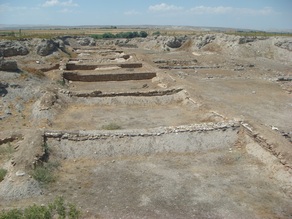 Ken explain to us the kinds of things archaeologists can know, what they wish they knew, why they think other kinds of records may no longer exist. And we learned that archaeologists sometimes revise their previous judgements. We visited the tomb of King Midas. Ken explained, though, that new dating suggested that the corpse was Midas’ father, making it still the tomb that Midas built, but not quite, well, the tomb in which he was buried.
Ken explain to us the kinds of things archaeologists can know, what they wish they knew, why they think other kinds of records may no longer exist. And we learned that archaeologists sometimes revise their previous judgements. We visited the tomb of King Midas. Ken explained, though, that new dating suggested that the corpse was Midas’ father, making it still the tomb that Midas built, but not quite, well, the tomb in which he was buried.
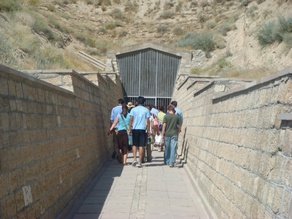
- Into the Tomb
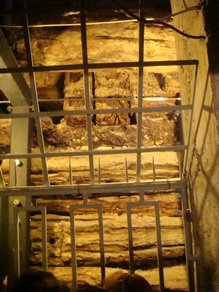
At the small museum next to the excavation, one of the graduate students working at the site explained that the local population had emulated Hellenistic pottery–it was quite the style in some circles. But they didn’t understand some of the Greek pottery’s particular functions, so their imitations are of great interest when analyzing cultural transmission. Ken had talked about the Greeks’ bringing their own languages and customs to Gordion–and to Anatolia generally–but both he and his student emphasized that the local, pre-Greek population remained present throughout the countryside. So what is a “Turk?” It was Phrygians who lived at Gordion–or anyway, it was a Phrygian government who ruled the people. And, it seems, the local population learned from the Greeks, but the Greeks also picked up some of the local customs.
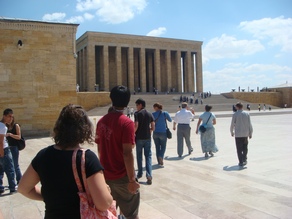
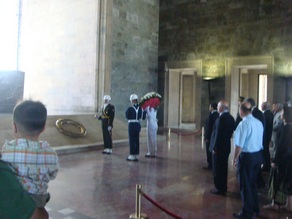
The second Ankara morning was devoted to Atatürk, of course. I got to stay at the dorms with an ill student while William took the students to Anıtkabir, Atatürk’s mausoleum and museum. Their guide was a friend’s father, a retired politician, former cultural minister, and a great admirer of the Founder. After reading of, talking about, and observing the Atatürk cult from afar, the students were able to get right to its center. I am sorry I missed it, but was delighted to hear about what the experience was like for them. (Check out their blogs, links on the right.)
By afternoon, everyone seemed well enough to go to the Museum of Anatolian Civilizations, where Thomas Zimmermann, archaeologist from Bilkent, talked to us about Turkey’s pre-history. He began outside, talking about the buildings themselves, how the project of taking Ottoman hans and turning them into an archaeological museum was an inherently political project. The goal was to claim a distinctly Turkish past, a past that predated the Ottomans, the Seljuks, and even the Byzantines. It reminded me of the new Lebanese state’s efforts to find its Phoenician past, and the nationalist Egyptians’ attempts to claim Pharonic origin. In this case, the new Turkish nationalists used archaeology to trace a very long historical trajectory, claiming that they descended from the Hattas and the Hittites.
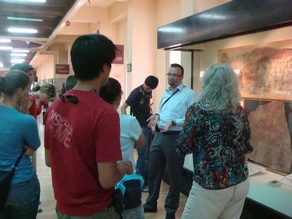
This is an award-winning museum, displayed well and labeled clearly, organized coherently and quite beautifully presented. It creates a linear historical path from pre-historical people to the Turkish present, almost ignoring the Greeks and Romans, who seem to be off limits– invaders instead of true inhabitants of the heartland. I found myself wondering how historians get to choose which groups are authentic and which are outsiders. But in any case, I think the students understand that there is much at stake in the project, more important than memorizing which artifacts go in which era.
Thomas’ fascination with metals was clear–it’s always exciting to have a teacher who is enthusiastic about his work.
Secularism, Turkish-style
We had to “finish” the history of Turkey this week, before we could really begin our travel around Turkey and the big projects. Feroz Ahmad’s narrative is not quite chronological, so we began Monday morning in a stereotypical, not quite creative, manner: building a collective timeline. But the timeline made Turkey’s political instability quite clear. How does Ahmad account for this instability? Taking the same information he presented, what other explanations might be possible?
We were immediately into a heady argument that seemed to recreate the dialogues among Turks over the past decades. It was the army, with its continuous interventions, that allowed politicians to be irresponsible and unaccountable because they always knew the military would fix the messes. No, no, the army was absolutely essential to the new Turkish Republic to keep it on the right path. It wasn’t the army, a third group argued, but the insistence on applying the principles of Kemalism in circumstances that demanded other approaches, the reification of decades-old goals and the controversies over how to implement them.
We ended the discussion before we had figured it out (of course!) in time to find our way to Suleymaniye, where my colleague Omid Safi had arranged a meeting with Istanbul’s mufti for both of our groups (and a few others). For the Burch students, it was an opportunity to try to understand the confusing relationship between Turkey’s religious and political institutions. They had just read an article by Haldun Gülalp explaining that secularism in the new Turkish Republic required both the privatization of faith (taking religion out of the public–and political–sphere) and, ironically, the control of the state over all religious institutions. The mufti spoke briefly, then answered questions. Some seemed strangely irrelevant, while others began to clear up our confusions. The mufti is employed by the government; he administers institutions that train those who do the call to prayer and the schools that train the jurists and control religious education in public schools.
We had to leave quickly to go to Yildiz University (our third campus tour) to talk with Professor Gulalp. The students asked him their questions about his article, about the relationship between the state and religion, and about his own answer to the morning’s question. Why is Turkey so unstable? He disagreed with all of their opinions, focusing instead on explaining how the military justifies their interventions (Rousseau’s notion of the difference between the popular will and the popular sentiment.) Once again, I was impressed with the students’ insights, and their clarity in both asking and responding to questions. Many carried the discussion into their own blogs (click links on the right).
